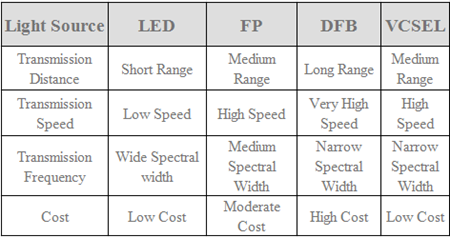In response to the increasing bandwidth demands facing data centers, network designers are paving the way for the introduction of 40Gbqs operations. Owing to this, telecommunication vendors continuously expand the portfolio of innovative parallel fiber optic transceivers to increase the 40G performance, resulting in 40G QSFP+ transceivers becoming the shining star on the market. 40G QSFP+ 40GBASE-iSR4 optics is the newly evolved products for 40G connectivity, but opportunity always besides with challenges. As people are so concerned about the future of their network, understanding the 40GBASE-iSR4 QSFP+ will be helpful for future high-performance Ethernet needs.
Why Move to 40G Ethernet Network
The volume of digital information flowing through data network develops at an ever increasing rate day by day. So the growth of cloud computing, server virtualization and the trend toward network convergence is forcing today’s networks to be more efficient and faster than ever. 1Gbps Ethernet access links have been replaced by 10Gbps links due to the increases in server utilization obtained through Virtualization. To keep up, higher performance switching hardware is needed to provide sufficient I/O (Input/Output) bandwidth to avoid blocking. In order to meet this demand, many newer access switches could support 48 ports of 10G Ethernet for connection to downstream servers, and 2 or 4 ports of 40G Ethernet for connection to the core switches. These 40G interconnects are implemented by using QSFP+ transceivers and could provide sufficient bandwidth to enable fully non-blocking switch fabrics.

QSFP+ is featured with various advantages like delivering excellent high speed optical/electrical performance coupled with low power dissipation. In addition, with bundled fiber cables and MPO connectors, the port density of QSFP+ modules is triple that of SFP+ modules. Moreover, the power consumption is reduced from 1000 mW maximum per lane for SFP+ to 375 mW maximum per lane for QSFP+. 40GBASE-iSR4 QSFP+ module like AFBR-79EIDZ is not only 40Gb Ethernet compliant, but also inter-operable with any 10GBASE-SR compliant transceiver at link distances up to 100 meters over OM3 multimode fiber. The letter “i” in 40GBASE-iSR4 QSFP+ refers to the ability of inter-operation. AFBR-79EIDZ see in Figure 1 is Avago 40GBASE-iSR4 QSFP+ transceiver available on the market. Just as any other modules, this Avago QSFP+ iSR4 is designed to be fully compatible with the 40GBASE-SR4 specification. It’s capable of inter-operating with legacy 10GBASE-SR transceivers.
40GBASE-iSR4 QSFP+—an Cost-Effective Solution
40GBASE-iSR4 QSFP+ transceiver was released to tackle the issue of an overload condition when connecting a 40GBASE-SR4 transmitter to a 10GBASE-SR receiver. It is intended to be fully compliant to the 40GBASE-SR4 specification but with a lower maximum transmit optical output power. The maximum specified output power has been lowered from +2.4 dBm to -1 dBm allowing it to interface with 10GBASE-SR receivers without fear of overload.

The VCSEL design combined with superior laser programming and control algorithms allow for a reduction in the module maximum specified optical output power without compromising any of the module high speed electro-optic performance. And the result (see in Figure 2) is a fully compliant 40GBASE-SR4 module like QSFP-40G-SR4 which can interoperate with legacy 10GBASE-SR transceivers. For further understanding of the 40GBASE-iSR4 optics, it is advisable for you to take a glance at the development of it.
Standardization of 40GBASE-iSR4
The release of IEEE 802.3ba-2010 standard for 40G Ethernet specifies the optical and electrical requirements for various physical layer link implementations. The 40GBASE-SR4 PMD (physical medium dependent) variant defines a 4-lane parallel optical interconnect for operation over OM3 multimode fiber with transmission distance up to 100 meters. Each of the four lanes works at a data rate of 10.3125 Gbps which is the same serial bit rate that was defined for 10G Ethernet links.
The 40GBASE-SR4 PMD addresses the need for 40Gbps interconnects in the data center. It takes advantage of the widely-deployed and low-cost 850nm VCSEL (vertical cavity surface emitting laser) technology. Because each of the 4 lanes in 40GBASE-SR4 have the same serial bit rate of 10G Ethernet link, there is an opportunity for switching hardware vendors to utilize 40GBASE-SR4 as 4 separate 10G Ethernet interconnects.
Challenge Hindering the Development
The standard of 40GBASE-SR4 provides an opportunity to further address the growing need for bandwidth. It is not defined to be backward compatible with the preceding 10G Ethernet short reach interconnect standard. Although both 40G Ethernet and 10G Ethernet included a PMD definition for short reach VCSEL based optical links operating at 10.3125 Gbps per lane, interoperability cannot be guaranteed.
The following analysis of 40GBASE-SR4 and 10GBASE-SR specifications tells why inter-operability cannot be guaranteed over all specified operating conditions.

From the above chart, we could see that many of the transmitter and receiver specifications governing the 10GBASE-SR standard are equal or more stringent than those for 40GBASE-SR4 standard. This is not surprising because the 40GBASE-SR4 specification is written to cover transmission links up to 100 meters, while the 10GBASE-SR specification is intended to satisfy a maximum transmission link length of 300 meters over OM3 multimode fiber. Except the distance, the main specification gap preventing guaranteed inter-operability relates to receiver overload.
Summary
40GBASE-iSR4 QSFP+ proves itself as a suitable solution for designers to mount their network capacity. QSFP+ iSR4 optics is able to support standard 40G Ethernet links up to 100 meters over OM3 and 10GBASE-SR links over the same distances. FS.COM offers a variety of 40G QSFP+ modules for you to choose from. The Avago compatible QSFP+ 40GBASE-iSR4 modules are also provided. For more information about Avago QSFP+, you van visit us.








